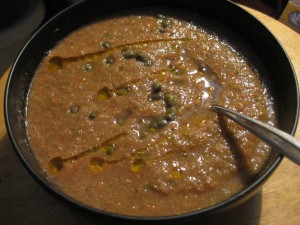 I’ve been on a gazpacho kick lately, since the cold tomato soup is easy to make and excellent summer fare. The other day, I was about to add a couple handfuls of basil to the blender, thinking, “Basil always goes well with tomatoes in Italian dishes.” And then I thought, “Wait, is this Italian or Spanish or something else?” And then I thought, “Man, I really don’t know much about gazpacho.” So I went hunting for some fun gazpacho history, and let me tell you, gazpacho has some murky little secrets it’s been keeping from you.
I’ve been on a gazpacho kick lately, since the cold tomato soup is easy to make and excellent summer fare. The other day, I was about to add a couple handfuls of basil to the blender, thinking, “Basil always goes well with tomatoes in Italian dishes.” And then I thought, “Wait, is this Italian or Spanish or something else?” And then I thought, “Man, I really don’t know much about gazpacho.” So I went hunting for some fun gazpacho history, and let me tell you, gazpacho has some murky little secrets it’s been keeping from you.
Gazpacho is, indeed, Spanish (though arguably Portuguese as well), specifically from the southern Andalusian region of the Iberian Peninsula. And it’s old, really old, though just how old is open to some debate. Some people think it might have its roots in Roman times, based on the fact that the oldest known recipes involve vinegar, and boy, those Romans loved their vinegar. But the more likely story is that the Moors brought over a soup from Morocco when they came to Andalusia around the 8th century, and the Andalusian peasants adopted it as their own since it was the perfect thing to eat while they were working in the fields.
Here’s the crazy part: wherever it came from, that original gazpacho had nary a tomato! It was a paste of garlic, stale bread, olive oil and vinegar, thinned into a soup with water. (A similar dish still exists in Andalusian cuisine, though it’s now called ajo blanco.) They might have added some vegetables and herbs when they were available, but tomatoes, cucumbers and peppers didn’t enter the gazpacho scene until much later, after Columbus brought them back to Europe from the Americas (What up, New World!?).
The name is also cloaked in mystery. Continue reading
